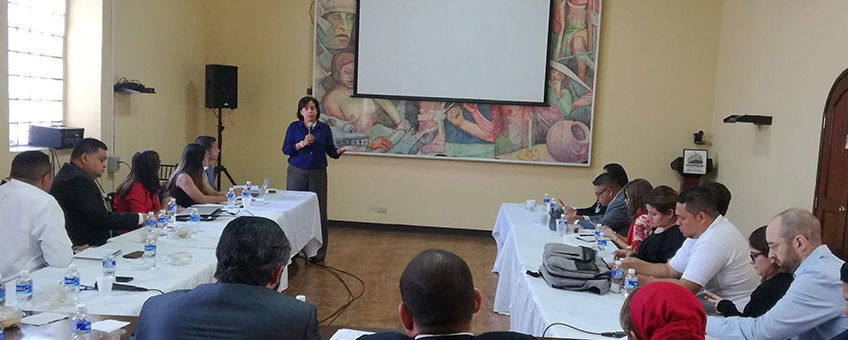- The institution developed different activities to define a route to drive trees on farm in the country.
March 25, 2019. With the objective of identifying elements to build a route that positions the concept of trees on farms in Honduras, CATIE (Tropical Agricultural Research and Higher Education Center) organized a series of events in this country within the framework of the project ” Taking advantage of the potential of trees on farms to meet national and international biodiversity objectives”.
This project, funded by Germany’s International Climate Initiative (IKI), lasts four years (2018-2022) and was designed by a consortium of institutions led by the World Agroforestry Centre (ICRAF) and integrated by CATIE, the International Union for Conservation of Nature (IUCN), the Center for International Forestry Research (CIFOR), George-August University in Gottingen and Leibnitz University in Hanover, both in Germany. Its objective is to highlight the contributions of on-farm trees (TonF) to biodiversity and other ecosystem services, and to support five countries (Rwanda, Uganda, Indonesia, Peru and Honduras) to include these contributions in reports to the Convention on Biological Diversity (CBD).
The CBD has set a series of targets to stop the loss of biodiversity in the world. One of these goals (Aichi 7) is for countries to implement more sustainable agricultural production systems that support biodiversity conservation. However, in Honduras TonF is relevant for other national objectives, such as the restoration program, the climate change mitigation and adaptation strategy, the climate financial inclusion initiative, private sector production objectives, among other important initiatives.
Among the events held, the project was socialized in the plenary session of the Environment and Climate Change Commission and the Agriculture and Livestock Commission of the National Congress of Honduras.
Edwin Garcia, project coordinator in Honduras for CATIE, commented that each representative spoke about the role of the project in supporting the objectives and strategies of their respective institutions, as well as the importance of trees on farm to conserve biodiversity, mitigate and adapt to climate change, for the restoration of degraded lands and income diversification.
“During this event it was agreed to work together to develop an enabling framework for the management and use of trees on farm; develop an agroforestry regulation headed by the ICF; prepare a proposal for incentives to promote trees on farm in the country that is led by the private sector,” said Garcia.
In addition to the deputies and members of the project team, representatives of the National Biodiversity Directorate (DIBio), the project’s focal point in the country, the Forest Conservation Institute (ICF, its Spanish acronym) and the National Federation of Honduran Farmers and Cattlemen (FENAGH, its Spanish acronym) also participated in this event.
Similarly, at the National University of Agriculture (UNA, its Spanish acronym) in Catacamas, Olancho, a workshop was held with the participation of more than 70 people from various sectors, who learned about the progress of the project and also contributed to identify elements and contributions to promote TonF at the local level.
According to Eduardo Somarriba, leader of CATIE’s Agriculture, Livestock and Agroforestry program, the sectors participating in the workshop showed great interest and willingness to promote actions in the territory.
“Among the established agreements, it was defined that the ICF and the TonF project will integrate to the Alliance for the Environment in Catacamas and together with the other key actors will develop actions, studies and samples considered in the project. In addition, a joint work plan will be developed to promote trees on the farm at the local level.
As part of the activities of this workshop, and in coordination with Heifer and the Association of Agroforestry Producers with Cocoa of Olancho (APROSACAO), a field tour was developed that included the visit of a cattle farm in the area of Santa Maria del Real and an agroforestry farm with cocoa in the community of El Indio, both in Catacamas. “In these field visits it was agreed to support the generation of inputs at the local level to support the development of the Agroforestry Regulation and the proposed incentive strategy to promote TonF, something that will be working in conjunction with the ICF, National Congress and other key actors. Along the same lines, it is intended to find spaces to train producers on the management of cocoa and silvopastoral systems by CATIE.
This series of events culminated with a workshop in Tegucigalpa, where more than 35 representatives at the central level of the different sectors participated: from the public sector; DIBIO, ICF, MiAmbiente, National Directorate of Climate Change (DNCC), Presidential Office of Climate Change, National Agrarian Institute(INA) , Secretariat for Agriculture and Livestock (SAG), Environment and Climate Change Commission of the National Congress From the private sector; the Honduran Coffee Institute (IHCAFE, its Spanish), the National Federation of Honduran Farmers and Cattlemen (FENAGH, its Spanish acronym), the Honduran Milk Chamber (CAHLE, its Spanish acronym); and the academic sector: Zamorano University, ICRAF, CATIE, CIRAD, U-Göttingen, among others.
This workshop discussed TonF’s contribution to the country’s commitments to international conventions on climate change and biodiversity and identified the next steps to promote TonF. Among the results of the workshop, the support expressed by ICF for the project, the support of the National Congress and the interest of the private sector stand out. “In the next few days we would be integrating a work team with all sectors to follow up on the agreements,” said Edwin Garcia.
AnjaGassner, ICRAF project leader, highlighted the importance of tres on farm worldwide and their contributions to biodiversity and other ecosystem services. According to Gassner, due to lack of information, tres on farm go unnoticed in development and restoration plans. “The project will demonstrate these contributions so that they are taken into account and cease to be invisible,” he said.
More information:
Edwin Garc
IKI-TonF Coordinator-Honduras
CATIE
egarcia@catie.ac.cr
Written by:
Priscilla Brenes Angulo
Communications Assistant
Information Technology and Communication
priscilla.brenes@catie.ac.cr

